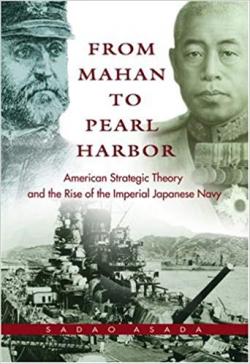From Mahan to Pearl Harbor: The Imperial Japanese Navy and the United States

By Sadao Asada
Naval Institute Press, Annapolis MD (2006)
ISBN 1-55750-042-8
Review by Ian Nish
Arma virumque cano. These two books (the second being 'The Impact of the Russo-Japanese War', Edited by Rotem Kowner and available here) deal with armaments and the men who used them. There has been a flood of books dealing with the Russo-Japanese War of 1904-5 published since the centenary. The distinctive feature of the book edited by Professor Kowner is that it deals with the impact the war had on Japan and Pussia and on practically all countries worldwide. The chapters are written by country experts and confirm the widely-accepted belief that there was hardly a country which was not affected by that war, especially those in Asia. These eighteen authors broadly agree that, although the war with Russia was not a global conflict, its impact was greater than the earlier Sino-Japanese war of 1894-5 and that its consequences were gradual, largely for financial reasons. It is not possible to make individual comments on the many insights in the book except for one general observation. This is the paradox that, whereas relations between the old enemies, Russia and Japan, changed from enmity to friendship by 1907, in the case of the United States, which had been host to the peace conference between the belligerents at Portsmouth, New Hampshire, relations with Japan deteriorated markedly and very quickly. As the editor writes, “the initial goodwill on both sides of the Pacific before and during the clash in Manchuria turned into a slow diplomatic deterioration” [Kowner, 15]. So much so that in 1907 the Americans updated their War Plan Orange to protect the waters of the Pacific Ocean against the Japanese menace, while Japan in her Imperial Defence Plan of that year declared the United States to be the “hypothetical enemy” of her navy.
1907 is in fact the starting-point of professor Asada's magisterial study which tells the story of American-Japanese naval relations from that year through to the outbreak of the Asia-Pacific war in 1941. In its 1907 Defence Plan Japan had set out the need for a 70 percent fleet ratio vis-à-vis the US Navy and the case for a buildup to an 8-8 fleet. Although the US had thus been recognized as an enemy of the future, Asada feels that the US and Japan had managed to reach a détente around the time of the Washington Naval Conference of 1921-2. But their failure to get acceptance of their claim for 70 per cent fleet ratio alienated large section of opinion in the Japanese navy. Thus, the Naval General Staff began to fight with the Navy Ministry after the death in 1923 of the strong-minded navy minister, Admiral Kato Tomosaburo, who was in Asada's view the navy's last effective leader. Generally speaking, the General Staff looked for a large fleet, while the ministry bureaucrats favoured meeting obligations under their existing naval limitation treaties like those of Washington and London. This conflict of ideas increased during the 1930s and the General Staff tended to exercise more influence over decision-making. After Japan distanced herself from the naval treaties in 1935-6, the new Imperial Defence Plan set out the navy's demands for expansion south, for acquisition of oil resources and for an increase in the size of the navy.
Professor Asada has published many articles on these subjects over the years as his research has progressed and now gives a clear and well-ordered distillation of his ideas.
His monograph is especially impressive on the Washington Conference and on the factions and personalities in the interwar navy. His book is the sequel to his authoritative book in Japanese on the same theme: Ryotaisenkan no Nichi-Bei kankei : Kaigun to seisaku kettei katei [Todai Shuppankai, 1993]. Specialists will find many new and original ideas in both books, while general readers will find them readable and coherent.
Wars and navies are still with us; and these volumes covering the first half of the twentieth century still have much relevance.

